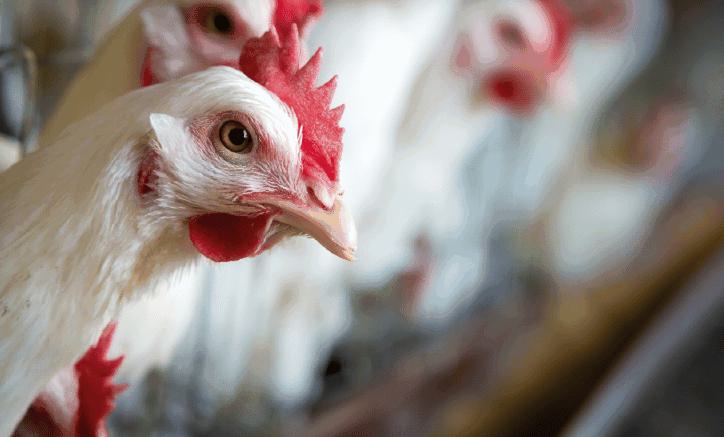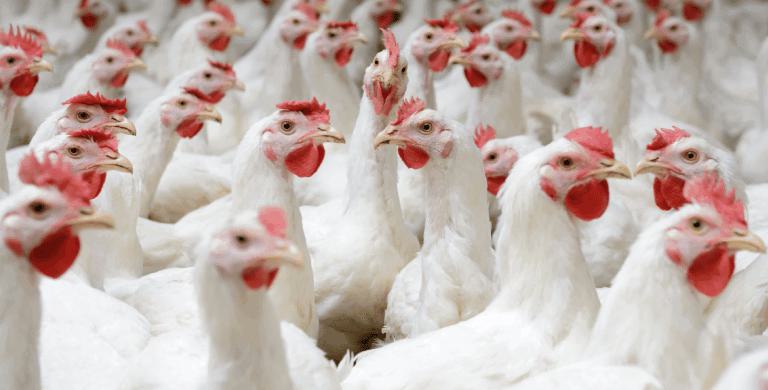The beneficial effects of Butyrate on intestinal health
Poultry Technology, September 2022
Butyrate is used as an important energy source for enterocytes, the epithelial cells of the intestine. Moreover, this organic acid has multiple beneficial effects on vital intestinal functions.
Butyrate: natural production or supplementation
Butyrate is naturally present in the digestive tract, especially in the lumen of the large intestine. The fermentation of dietary fibers from the diet by the microbial population inhabiting the intestinal tract results in the production of short chain fatty acids (SCFAs). Acetate, propionate and in particular butyrate production beneficially affect the intestinal health. Most of the produced SCFAs are very rapidly absorbed and metabolized as energy sources or function as signaling molecules. The quantity of butyrate produced in the colonic lumen depends on the composition of the microbiota and on the amount of fermentable substrates available in the diet. Intestinal infections, chronic inflammatory disorders and the use of antibiotics negatively affect the colonic microbiota and may result in reduced production of butyrate. Alternatively, the positive effect of butyrate can also be achieved by direct addition of this SCFA to the diet. The application of butyrate in the diet is well known and butyrate products are widely used in different animal species for their beneficial effects in enhancing animal performance. Unprotected butyrate will be directly absorbed in the first part of the digestive tract before reaching the lower intestines. Micro-encapsulation of butyrate results in a more targeted release of active butyrate over the whole digestive tract, increasing its effectiveness.

Importance of butyrate for gut integrity
Butyrate plays an important role in the development of the intestinal epithelium. It can be utilized by the intestinal epithelial cells as an energy source and stimulates their differentiation and proliferation. The intestinal mucosa is one of the most rapidly replicating tissues in the body and therefore a sufficient energy supply is essential for villi development, gut morphology and absorptive function. Whereas most other cell types utilize glucose as their primary energy source, colonocytes have a great capacity to metabolize butyrate for the production of adenosine triphosphate (ATP) and thus energy. Moreover, butyrate shows to improve the physical intestinal barrier function. The function of the epithelial layer as defense barrier is of great importance, as this single layer of cells needs to protect the inner body of the animal from constant challenges by microbes, toxins, pathogens and other foreign substances. Butyrate has a positive effect on the tight junctions, increasing the connection between cells and improving the barrier strength. As precursor for de novo synthesis of lipids used for cell membranes, butyrate contributes to the maintenance of barrier and transporter functions of the gut. Additionally, there are indications that butyrate stimulates the formation of mucin glycoproteins. These mucin glycoproteins are essential in the mucus layer which protects the intestinal epithelium and forms an additional part of the defense barrier of the colon mucosa.
For newborn animals, quantities of intestinal produced butyrate can be small, although it is an important factor in the development of the growing gastrointestinal tract. Supplemental butyrate in young animals results in beneficial effects on gut development and intestinal function, optimizing both gut and general health.
Pathogen reduction
As organic acid, butyrate also exhibits antimicrobial potency. Undissociated acids, in their uncharged lipophilic form, can cross the (bacterial) cell membrane. Intracellularly they will dissociate, resulting in an increased proton concentration and reduction of pH. Protons will be transported outside the cell on the expense of cellular energy. The accumulation of organic acid anions in the cytoplasm results in metabolic perturbation and compromised function. Bacteria differ in their sensitivity towards organic acids and the effects of different organic acids may vary with environmental pH.
Another mechanistic explanation on the antimicrobial efficacy of butyrate is discussed by the research group of Van Immerseel (2006). An early step in the pathogenesis of bacteria, like Salmonella, is the interaction between the bacteria and host cells. Already with low levels of butyrate, it was observed that the expression of invasion genes in Salmonella bacteria was down regulated. Hereby, the ability to attach to host cells of the intestinal epithelium is reduced, and it prevents Salmonella of becoming invasive and virulent. Other studies confirm the efficacy of butyrate in preventing the colonization of other pathogens such as E. coli.
Unlike other organic acids which have mainly antibacterial properties, butyric acid also acts as energy source for epithelial cells and as an important signaling molecule. The positive effects of butyrate on intestinal health have already been described in many reports. In broiler chickens, supplementation of butyrate in feed can beneficially influence intestinal villi structure and improve growth rate and feed conversion. It is also observed that the birds’ immune response is improved, and pro-inflammatory pathways are downregulated.

Immune modulation and anti-inflammatory effect
Butyrate has the ability to influence gene expression of cells. In normal cells, butyrate activates gene expression for cell proliferation and maturation, while in abnormal cells (e.g. cancer cells), early apoptosis is induced. Via inhibition of the activation of nuclear factor kappa B (NF-κB) in colonic epithelial cells, butyrate also has a role as anti-inflammatory agent. NF-κB regulates many cellular genes involved in early inflammatory responses and is frequently deregulated in inflammatory bowel diseases. Butyrate administration demonstrated to be effective in reduction of inflammatory parameters in the large intestine.
Another role for butyrate in the host defense and immune system is the stimulation of the production of host defense peptides (HDPs). These antimicrobial peptides (e.g. defensins and cathelicidins) possess broad-spectrum antimicrobial activities against bacteria, protozoa, enveloped viruses and fungi. HDPs are essential effector molecules of the innate immune system and are of great importance in bacterial host defense. They can bind to different types of microbial membranes, causing membrane disruption which results in microbial death. Results from a study in chickens revealed that butyrate increases the antibacterial activity of host immune cells by up-regulation of an array of HDPs in vitro and in vivo. This immune defense was coupled with a minimum impact on immune cell activation and inflammation. This makes the up-regulation of HDPs an important line of defense and an interesting approach in alternative strategies to reduce the use of antibiotics. Extensive use of antibiotics leads to the emergence of antimicrobial resistance, which is not only an issue in livestock, but also increases concerns for public health. Alternative strategies are therefore required to maintain animal performance without the extensive use of antibiotics and associated risks.
In poultry, it is shown that coated butyrate is superior to uncoated butyric acid in reducing intestinal Salmonella colonization.

Practical usage of butyrate in feed
As a feed additive, butyrate can be fed in the form of butyrate glycerides or butyrate salts (Na- and Ca-salt). Uncoated butyrate is directly available and will immediately be absorbed in the first part of the digestive tract before reaching the lower part of the intestine. To obtain maximal benefit and in order to exert influence in the lower intestine, dietary butyrate should slowly be released over the gastrointestinal tract.
The aim of a coating or (micro-)encapsulation is to have a targeted release in the whole digestive tract. Microencapsulation by a protective lipid matrix allows slow release of active butyrate over the digestive tract, preventing the immediate disappearance of the ingredient. Especially butyrate delivered over the whole digestive tract affects digestive function, microbiota composition and immune responses.
In poultry, it is shown that coated butyrate is superior to uncoated butyric acid in reducing intestinal Salmonella colonization. Thereby environmental contamination and transmission of Salmonella to other uninfected animals was reduced in the coated butyrate group. The researchers suggest that uncoated butyrate is taken up by the cells in the upper digestive tract, whereas coated butyric acid will influence Salmonella bacteria at the site of the colonization in the gut. Making profit in the poultry industry is often determined by the incidence of infectious diseases. Necrotic enteritis is globally an important concern because of production losses, increased mortality, increased veterinary and medication costs, reduced welfare of birds and an increased chance of contamination of products for human consumption. The pathology of necrotic enteritis consists of a primary intestinal damage caused by coccidiosis, followed by infection with the bacterium Clostridium perfrigens. Although coccidiostats or other antimicrobial agents are commonly used to control the pathogenic pressure in the flock, the emergence of resistance can induce a real problem. Therefore, the poultry industry needs to search for alternative management and dietary strategies to control coccidiosis and necrotic enteritis. One of the dietary treatments could be the addition of butyrate, an energy source for epithelial cells that reinforces the intestinal barrier function. Also improved fecal consistency and reduction of wet litter can be beneficial effects of butyrate, with positive impact on the performance and profit of poultry farms.
The type of coating influences the release of butyrate over the digestive tract. To be delivered over the whole digestive tract, a product with sustained release of butyrate is essential. Proper coating should not be decomposed in the stomach and should be gradually released in the presence of fat degrading enzymes. With dissolution tests the release rate of coated sodium butyrate products can be tested and analyzed. This is done by simulating the same conditions of the stomach and intestinal tract. The test of a coated sodium butyrate 30% showed that all butyrate is passing the stomach and is gradually released in the intestinal fluid. In addition to targeted release of butyrate over the digestive tract, correct coating reduces the typical unpleasant smell of butyrate.
Conclusion
Butyrate is essential as an energy source for epithelial cells and vital intestinal function. Diverse beneficial effects of butyrate on animal health can be achieved by addition of butyrate to the diet. Use of proper microencapsulated butyrate, results in targeted release of the SCFA over the digestive tract. A slow release alongside the gastrointestinal tract, ensures all cells can profit from the butyrate benefits to obtain maximal result, enhancing animal performance.
